Long Quan
Matrix3D: Large Photogrammetry Model All-in-One
Feb 11, 2025Abstract:We present Matrix3D, a unified model that performs several photogrammetry subtasks, including pose estimation, depth prediction, and novel view synthesis using just the same model. Matrix3D utilizes a multi-modal diffusion transformer (DiT) to integrate transformations across several modalities, such as images, camera parameters, and depth maps. The key to Matrix3D's large-scale multi-modal training lies in the incorporation of a mask learning strategy. This enables full-modality model training even with partially complete data, such as bi-modality data of image-pose and image-depth pairs, thus significantly increases the pool of available training data. Matrix3D demonstrates state-of-the-art performance in pose estimation and novel view synthesis tasks. Additionally, it offers fine-grained control through multi-round interactions, making it an innovative tool for 3D content creation. Project page: https://nju-3dv.github.io/projects/matrix3d.
DepthCrafter: Generating Consistent Long Depth Sequences for Open-world Videos
Sep 03, 2024
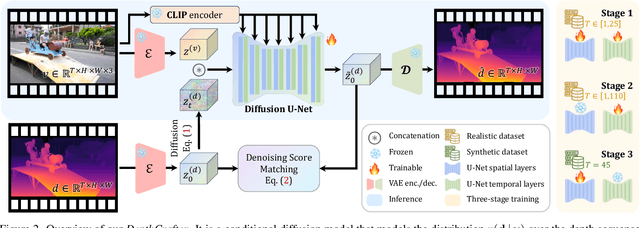

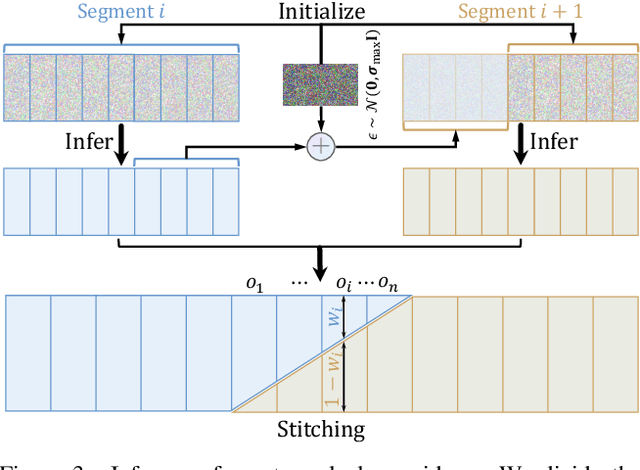
Abstract:Despite significant advancements in monocular depth estimation for static images, estimating video depth in the open world remains challenging, since open-world videos are extremely diverse in content, motion, camera movement, and length. We present DepthCrafter, an innovative method for generating temporally consistent long depth sequences with intricate details for open-world videos, without requiring any supplementary information such as camera poses or optical flow. DepthCrafter achieves generalization ability to open-world videos by training a video-to-depth model from a pre-trained image-to-video diffusion model, through our meticulously designed three-stage training strategy with the compiled paired video-depth datasets. Our training approach enables the model to generate depth sequences with variable lengths at one time, up to 110 frames, and harvest both precise depth details and rich content diversity from realistic and synthetic datasets. We also propose an inference strategy that processes extremely long videos through segment-wise estimation and seamless stitching. Comprehensive evaluations on multiple datasets reveal that DepthCrafter achieves state-of-the-art performance in open-world video depth estimation under zero-shot settings. Furthermore, DepthCrafter facilitates various downstream applications, including depth-based visual effects and conditional video generation.
Mani-GS: Gaussian Splatting Manipulation with Triangular Mesh
May 28, 2024Abstract:Neural 3D representations such as Neural Radiance Fields (NeRF), excel at producing photo-realistic rendering results but lack the flexibility for manipulation and editing which is crucial for content creation. Previous works have attempted to address this issue by deforming a NeRF in canonical space or manipulating the radiance field based on an explicit mesh. However, manipulating NeRF is not highly controllable and requires a long training and inference time. With the emergence of 3D Gaussian Splatting (3DGS), extremely high-fidelity novel view synthesis can be achieved using an explicit point-based 3D representation with much faster training and rendering speed. However, there is still a lack of effective means to manipulate 3DGS freely while maintaining rendering quality. In this work, we aim to tackle the challenge of achieving manipulable photo-realistic rendering. We propose to utilize a triangular mesh to manipulate 3DGS directly with self-adaptation. This approach reduces the need to design various algorithms for different types of Gaussian manipulation. By utilizing a triangle shape-aware Gaussian binding and adapting method, we can achieve 3DGS manipulation and preserve high-fidelity rendering after manipulation. Our approach is capable of handling large deformations, local manipulations, and soft body simulations while keeping high-quality rendering. Furthermore, we demonstrate that our method is also effective with inaccurate meshes extracted from 3DGS. Experiments conducted demonstrate the effectiveness of our method and its superiority over baseline approaches.
Affine-based Deformable Attention and Selective Fusion for Semi-dense Matching
May 22, 2024



Abstract:Identifying robust and accurate correspondences across images is a fundamental problem in computer vision that enables various downstream tasks. Recent semi-dense matching methods emphasize the effectiveness of fusing relevant cross-view information through Transformer. In this paper, we propose several improvements upon this paradigm. Firstly, we introduce affine-based local attention to model cross-view deformations. Secondly, we present selective fusion to merge local and global messages from cross attention. Apart from network structure, we also identify the importance of enforcing spatial smoothness in loss design, which has been omitted by previous works. Based on these augmentations, our network demonstrate strong matching capacity under different settings. The full version of our network achieves state-of-the-art performance among semi-dense matching methods at a similar cost to LoFTR, while the slim version reaches LoFTR baseline's performance with only 15% computation cost and 18% parameters.
ConTex-Human: Free-View Rendering of Human from a Single Image with Texture-Consistent Synthesis
Nov 28, 2023



Abstract:In this work, we propose a method to address the challenge of rendering a 3D human from a single image in a free-view manner. Some existing approaches could achieve this by using generalizable pixel-aligned implicit fields to reconstruct a textured mesh of a human or by employing a 2D diffusion model as guidance with the Score Distillation Sampling (SDS) method, to lift the 2D image into 3D space. However, a generalizable implicit field often results in an over-smooth texture field, while the SDS method tends to lead to a texture-inconsistent novel view with the input image. In this paper, we introduce a texture-consistent back view synthesis module that could transfer the reference image content to the back view through depth and text-guided attention injection. Moreover, to alleviate the color distortion that occurs in the side region, we propose a visibility-aware patch consistency regularization for texture mapping and refinement combined with the synthesized back view texture. With the above techniques, we could achieve high-fidelity and texture-consistent human rendering from a single image. Experiments conducted on both real and synthetic data demonstrate the effectiveness of our method and show that our approach outperforms previous baseline methods.
Direct2.5: Diverse Text-to-3D Generation via Multi-view 2.5D Diffusion
Nov 27, 2023Abstract:Recent advances in generative AI have unveiled significant potential for the creation of 3D content. However, current methods either apply a pre-trained 2D diffusion model with the time-consuming score distillation sampling (SDS), or a direct 3D diffusion model trained on limited 3D data losing generation diversity. In this work, we approach the problem by employing a multi-view 2.5D diffusion fine-tuned from a pre-trained 2D diffusion model. The multi-view 2.5D diffusion directly models the structural distribution of 3D data, while still maintaining the strong generalization ability of the original 2D diffusion model, filling the gap between 2D diffusion-based and direct 3D diffusion-based methods for 3D content generation. During inference, multi-view normal maps are generated using the 2.5D diffusion, and a novel differentiable rasterization scheme is introduced to fuse the almost consistent multi-view normal maps into a consistent 3D model. We further design a normal-conditioned multi-view image generation module for fast appearance generation given the 3D geometry. Our method is a one-pass diffusion process and does not require any SDS optimization as post-processing. We demonstrate through extensive experiments that, our direct 2.5D generation with the specially-designed fusion scheme can achieve diverse, mode-seeking-free, and high-fidelity 3D content generation in only 10 seconds. Project page: https://nju-3dv.github.io/projects/direct25.
HiFi-123: Towards High-fidelity One Image to 3D Content Generation
Oct 10, 2023Abstract:Recent advances in text-to-image diffusion models have enabled 3D generation from a single image. However, current image-to-3D methods often produce suboptimal results for novel views, with blurred textures and deviations from the reference image, limiting their practical applications. In this paper, we introduce HiFi-123, a method designed for high-fidelity and multi-view consistent 3D generation. Our contributions are twofold: First, we propose a reference-guided novel view enhancement technique that substantially reduces the quality gap between synthesized and reference views. Second, capitalizing on the novel view enhancement, we present a novel reference-guided state distillation loss. When incorporated into the optimization-based image-to-3D pipeline, our method significantly improves 3D generation quality, achieving state-of-the-art performance. Comprehensive evaluations demonstrate the effectiveness of our approach over existing methods, both qualitatively and quantitatively.
JointNet: Extending Text-to-Image Diffusion for Dense Distribution Modeling
Oct 10, 2023Abstract:We introduce JointNet, a novel neural network architecture for modeling the joint distribution of images and an additional dense modality (e.g., depth maps). JointNet is extended from a pre-trained text-to-image diffusion model, where a copy of the original network is created for the new dense modality branch and is densely connected with the RGB branch. The RGB branch is locked during network fine-tuning, which enables efficient learning of the new modality distribution while maintaining the strong generalization ability of the large-scale pre-trained diffusion model. We demonstrate the effectiveness of JointNet by using RGBD diffusion as an example and through extensive experiments, showcasing its applicability in a variety of applications, including joint RGBD generation, dense depth prediction, depth-conditioned image generation, and coherent tile-based 3D panorama generation.
NeILF++: Inter-Reflectable Light Fields for Geometry and Material Estimation
Mar 30, 2023Abstract:We present a novel differentiable rendering framework for joint geometry, material, and lighting estimation from multi-view images. In contrast to previous methods which assume a simplified environment map or co-located flashlights, in this work, we formulate the lighting of a static scene as one neural incident light field (NeILF) and one outgoing neural radiance field (NeRF). The key insight of the proposed method is the union of the incident and outgoing light fields through physically-based rendering and inter-reflections between surfaces, making it possible to disentangle the scene geometry, material, and lighting from image observations in a physically-based manner. The proposed incident light and inter-reflection framework can be easily applied to other NeRF systems. We show that our method can not only decompose the outgoing radiance into incident lights and surface materials, but also serve as a surface refinement module that further improves the reconstruction detail of the neural surface. We demonstrate on several datasets that the proposed method is able to achieve state-of-the-art results in terms of geometry reconstruction quality, material estimation accuracy, and the fidelity of novel view rendering.
ASpanFormer: Detector-Free Image Matching with Adaptive Span Transformer
Aug 30, 2022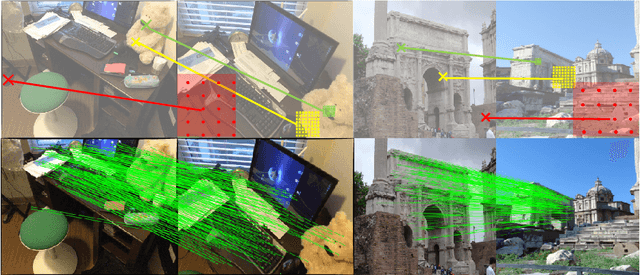
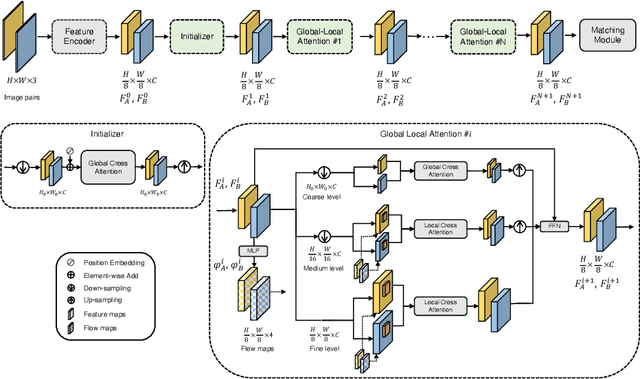

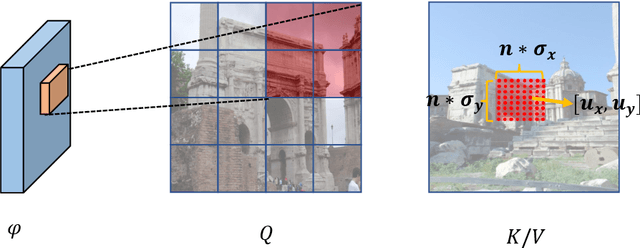
Abstract:Generating robust and reliable correspondences across images is a fundamental task for a diversity of applications. To capture context at both global and local granularity, we propose ASpanFormer, a Transformer-based detector-free matcher that is built on hierarchical attention structure, adopting a novel attention operation which is capable of adjusting attention span in a self-adaptive manner. To achieve this goal, first, flow maps are regressed in each cross attention phase to locate the center of search region. Next, a sampling grid is generated around the center, whose size, instead of being empirically configured as fixed, is adaptively computed from a pixel uncertainty estimated along with the flow map. Finally, attention is computed across two images within derived regions, referred to as attention span. By these means, we are able to not only maintain long-range dependencies, but also enable fine-grained attention among pixels of high relevance that compensates essential locality and piece-wise smoothness in matching tasks. State-of-the-art accuracy on a wide range of evaluation benchmarks validates the strong matching capability of our method.
 Add to Chrome
Add to Chrome Add to Firefox
Add to Firefox Add to Edge
Add to Edge